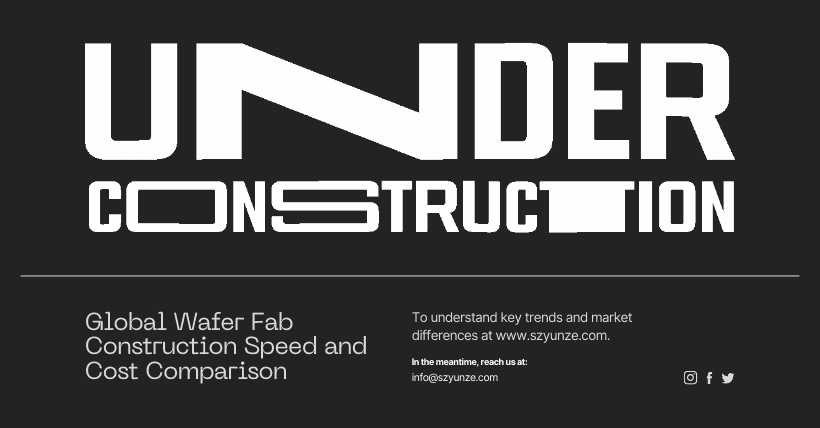The semiconductor industry is currently in a rapid expansion phase, with countries and regions around the world competing to build new chip manufacturing plants (fabs). According to data from Exyte, a leading engineering, construction, and design company focusing on chip production facilities and other high-tech infrastructure, and reported by Semiconductor Digest: in Taiwan, building a fab takes only about 19 months; whereas in the U.S., the same construction work takes as long as 38 months. The main reason for this significant time difference is that in the U.S., obtaining construction permits takes a long time, and fab construction is not carried out 24/7. In contrast, Taiwan’s permitting process is more streamlined and efficient, and construction work is conducted around the clock.
The construction timelines in other regions also vary: Singapore and Malaysia require 23 months, European projects take 34 months, while the U.S. is the slowest at 38 months. (Note: The article does not provide data on mainland China’s fab construction timelines.)
| Region | License and Design (Month) | Construction Start Time (Month) | Construction Time (Months) | Total Duration (Months) |
|---|---|---|---|---|
| United States | 14-20 | 14 | 24 | 38 |
| Europe | 10-18 | 10 | 24 | 34 |
| Singapore and Malaysia | 7-15 | 7 | 16 | 23 |
| Taiwan | 6-13 | 6 | 13 | 19 |
A key factor behind this disparity is the approval process and construction schedule. Taiwan’s efficient permitting mechanism and 24/7 construction significantly shorten the construction period, while the U.S. and Europe face more challenges due to approval delays and non-continuous construction work. Although the U.S. has passed laws to waive federal environmental assessments for some fabs, this is clearly not enough to compete with Taiwan.
The cost differences are also significant. According to Exyte, it costs about twice as much to build a fab in the U.S. compared to Taiwan, even though equipment costs are similar in both regions. This gap is due to higher labor costs in the U.S., complex regulatory requirements, and inefficient supply chains. In addition, Taiwan’s labor force is highly experienced. According to Exyte executive Herbert Blaschitz, the construction teams in Taiwan are familiar with each process step, which reduces the need for detailed blueprints and accelerates project completion.
To compete with Taiwan—whose supply chain is highly integrated, its labor force experienced, and its regulatory process efficient—the U.S. and Europe must simplify permitting procedures, optimize construction techniques, and adopt advanced planning tools such as digital twin technology. Blaschitz suggests using “virtual commissioning,” which involves creating a digital model of the plant before physical construction begins to identify potential problems in advance, thereby reducing costs and environmental impact, while improving speed and efficiency.
Modern semiconductor production facilities are vast, both in terms of physical space and investment. According to Blaschitz’s presentation at the SEMI Industry Strategy Symposium, a cutting-edge fab (such as one operated by Intel, Samsung, or TSMC) requires an investment of over $20 billion, with the building itself accounting for $4 to $6 billion. The construction process involves 30 to 40 million labor hours, the use of 83,000 tons of steel, nearly 9,000 kilometers of wiring, and 600,000 cubic meters of concrete. A typical fab may include 40,000 square meters of cleanrooms, equipped with 2,000 pieces of production equipment for operations like photolithography, deposition, etching, and cleaning, each requiring around 50 independent utility and process connections.
In conclusion, to gain an advantage in the global semiconductor race, the U.S. and Europe must learn from Taiwan, optimize processes, improve efficiency, and increase technological investments to meet the demands of this rapidly evolving industry.

Disclaimer:
- This channel does not make any representations or warranties regarding the availability, accuracy, timeliness, effectiveness, or completeness of any information posted. It hereby disclaims any liability or consequences arising from the use of the information.
- This channel is non-commercial and non-profit. The re-posted content does not signify endorsement of its views or responsibility for its authenticity. It does not intend to constitute any other guidance. This channel is not liable for any inaccuracies or errors in the re-posted or published information, directly or indirectly.
- Some data, materials, text, images, etc., used in this channel are sourced from the internet, and all reposts are duly credited to their sources. If you discover any work that infringes on your intellectual property rights or personal legal interests, please contact us, and we will promptly modify or remove it.



